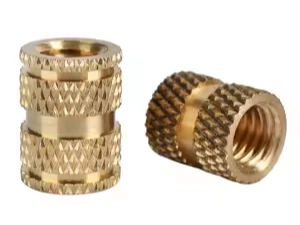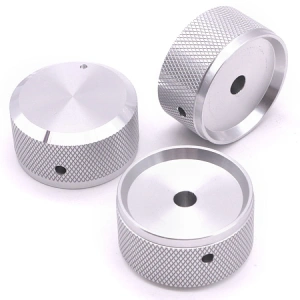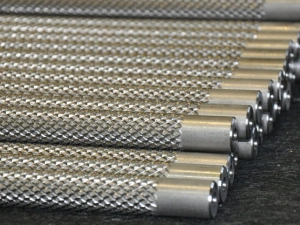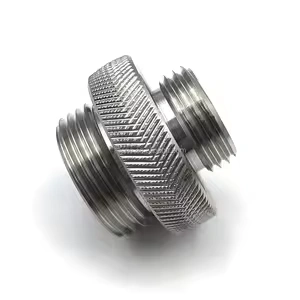CAPABILITIES
CNC Knurling Service
Prolean offers reliable and precise CNC knurling services for various needs.
- Custom knurling for unique, low-volume projects.
- Expertise in knurling over 50 materials.
- Support from prototype to production.
- Rigorous quality checks for excellent surfaces.






All uploads are secure and confidential.
What is CNC Knurling?
CNC Knurling is a metalworking process that creates a patterned texture on ductile metals to improve grip and aesthetic appeal.
The process involves applying pressure with a tool that has a negative image of the desired pattern onto a metal piece rotating on a lathe.
This technique is commonly used for parts like handles, knobs, and thumbscrews.
The most typical knurling patterns are straight-line, angular, and cross-hatch.

Try Prolean Now!
Different Types of Knurling Patterns
Knurling is used where there is a need to increase friction between two surfaces, and for design, the knurling patterns vary depending on the use. Below is an overview of the main types of knurling patterns and their applications:

- Straight Knurling
The straight knurling wheel creates a linear, uniform pattern on the workpiece without any angular orientation. It is ideal for processes needing a consistent surface finish.

- Diamond Knurling
Diamond knurling creates a diamond-shaped pattern by arranging the wheel’s teeth to slope in both directions, offering excellent grip. It is used on tools, handles, and knobs and comes in two types: female (raised diamond pattern) and male (pattern-cutting tool).

- Beveled Knurling
Traversing or cross knurling operations also employ beveled knurls, as the teeth are inclined and can slide gently on the surface with less force applied to the teeth’ edges. Both are selected based on the intended application of knurling and the desired outcome.
How to Order Parts?
Get a free quote from a real engineer; once we receive your design, our engineer will review it and send you a quote as fast as one hour.
Get A Quote Immediately
Upload your design or email our engineer directly and get your quotes as fast as one hour.
Start Production
Your parts will be made once your orders are confirmed. Besides, you will get real-time order updates of the production status from our order tracking system.
Receive Your Part
After all parts pass QC inspection, they will be well packed from transportation accidents. Then, your custom parts are delivered straight to your doorstep.
Overview of the Knurling Process
Knurling is usually performed on a lathe tool in which patterns are embossed on a workpiece using a knurling tool. This process can be a subtraction or a cold working process.
Determining Method:
Knurling can be done manually by rolling a tool on softer metals or mechanically cutting a tool on harder metals for a better finish.
Forming the Pattern:
Constant pressure should also be applied as the knurling wheel cuts the pattern on the workpiece. Several passes may be necessary on harder materials to achieve the right surface finish.
CNC Knurling Material Options
Brass, with its golden hue, offers low friction, superior machinability, and high electrical and thermal conductivity, making it ideal for low-friction tasks. Brass is used in decorative items, valves, and precision items such as locks and handles.
Very light and not easily corroded. Knurling aluminum is often used to fabricate components of space vehicles, automobile trinkets, and electronic equipment’s outer casing.
High mechanical strength, Thermal, Wear, and Corrosion resistance. Stainless steel is low-cost and can be machined easily. Parts made from Stainless steel are durable and do not lose that strength over time.
High mechanical strength, toughness, resistance to wear and fatigue, and sturdiness. In addition to carbon, other alloying elements can be added depending on the needed mechanical and physical qualities.
Try Prolean Now!
CNC Knurling Part Finishing Options

Standard (As-Machined)
This finish refers to parts just after the machining process, sometimes followed by minor grinding. It contains tool marks, small burrs & chips, but provides tight tolerances. The roughness can be as low as 3.2 μm. This finish is suitable when aesthetics is not a requirement.

Polishing
Polishing can be applied through electrochemical and mechanical methods. It produces a smooth and fine, mirror-like finish with Ra as low as 0.3 μm. This surface finish is preferred for machined parts if low-surface friction is essential for performance or aesthetics is important.

Anodized (Type II Or Type III)
The CNC-machined aluminum or non-ferrous parts can be anodized, which refers to adding and protective oxide layer on their surface. Type II is clear and color anodizing, whereas type III (MIL-A-8625/MIL-PRF-8625) refers to hard coating. Anodized surfaces resist harsh environments and save the parts from corrosion, wear, and surface degradation.
CNC Knurling Applications

Automotive
Knurled fasteners provide a firm assembly in automotive applications. Knurled knobs and handles improve ease of use, while thrust washers enhance contact pressure in drivetrain components, and knurled shafts increase surface friction on axles.

Aerospace
In aerospace, CNC knurling is used on fasteners for anti-vibration, rotary knobs for better control, and precision shafts in engines and landing gear to prevent slippage.

Electronics
CNC knurling on knobs and dials improves grip on electronic gadgets. Knurled connectors ensure good electrical contact and knurled enclosures enhance usability and aesthetics.

Medical
Medical equipment like knobs, razors, and instruments have knurled handles for better grip. Precision knurled valves and knobs ensure proper fluid handling, and knurled orthopedic implements are more effective.
3 Ways to Ensure Perfection
Precision and Accuracy
Our precision machines and state-of-the-art software ensure accuracy and consistency in every product we create. Strict quality control processes guarantee that every product meets our high standards and is exactly to specification.
Skilled Technicians
Our technicians are highly trained and experienced in all aspects of machine processing. Their expertise and attention to detail ensure that every product we produce is of the highest quality.
Advanced Technology
We invest in the latest technology and equipment to provide our customers with the highest quality machine processing services. Our cutting-edge technology guarantees efficiency and effectiveness in all our production processes.
CNC Knurling FAQ’s
General FAQ:
Why is knurling important?
Knurling is essential in that it adds texture to a part so that it can have a better grip and also for its longevity. It gives a rough feel to the surface and thus offers a good grip on the object being held. Furthermore, knurling can restore worn surfaces and thus increase the service life of the components.
Which machine is most suitable for knurling surfaces?
A lathe is the most appropriate machine for making a knurled finish. The workpiece is rotated while a fixed knurling tool cuts the pattern, ensuring uniform knurling on the various materials.
What should the optimal cutting speed be when knurling?
As for other turning operations, the appropriate cutting speed for knurling is recommended. The surface speed should be maintained at about 150 feet per minute (or 50 meters per minute) to prevent tool binding problems and attain a polished look.
Technical FAQ:
What is the difference between CNC knurling and engraving?
CNC Knurling rolling tools change a surface’s shape with patterns that help grip and strengthen it. The engraving technique uses a single-point tool to cut intricate designs on the surface by removing material. Knurling is normally applied to functional patterns, while engraving is applied to intricate ornamental patterns.
Is CNC Knurling optimal for Wood machining?
Wood knurling is more complex than metal knurling and is typically applied only to hardwoods. Although knurling is not used on wood, a similar process called checkering gives patterns on wooden surfaces.
What kinds of knurling tools are there?
Knurling wheels emboss patterns onto rotating surfaces, which come in many patterns. Knurling dies are mostly made of high-speed steel and used to cut internal knurls on cylindrical jobs. Floating knurling tools are designed to float over the surface of the workpiece and adapt to the irregularities in the surface for a better grip. At the same time, knurling inserts are fitted directly on the lathes to produce specific patterns. Push-type knurling tools are hand-operated for performing knurling operations.
Get Your Parts Made Today
All uploads are secure and confidential.









